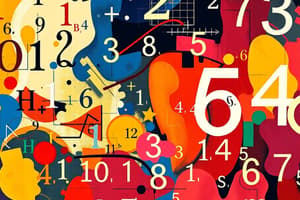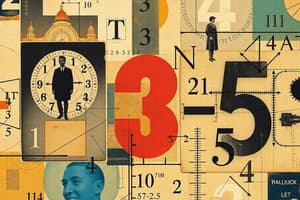Podcast
Questions and Answers
What does a derivative represent in calculus?
What does a derivative represent in calculus?
- The rate of change of a function (correct)
- The total accumulated value of a function
- The limit of a function as it approaches a value
- The area under a curve
Which measure of central tendency represents the middle value when data is organized in order?
Which measure of central tendency represents the middle value when data is organized in order?
- Standard Deviation
- Mean
- Mode
- Median (correct)
Which notation is used to represent the union of two sets A and B?
Which notation is used to represent the union of two sets A and B?
- A - B
- A ∪ B (correct)
- A × B
- A ∩ B
In probability, which term refers to the likelihood of an event occurring?
In probability, which term refers to the likelihood of an event occurring?
Which of the following is typically NOT considered a representation of data dispersion?
Which of the following is typically NOT considered a representation of data dispersion?
Which of the following sets includes all irrational numbers?
Which of the following sets includes all irrational numbers?
What is the correct order of operations to solve the expression $3 + 6 \times (5 + 4) \div 3$?
What is the correct order of operations to solve the expression $3 + 6 \times (5 + 4) \div 3$?
Which mathematical area focuses on collecting and interpreting data?
Which mathematical area focuses on collecting and interpreting data?
What defines a linear equation?
What defines a linear equation?
Which of the following is an example of a complex number?
Which of the following is an example of a complex number?
What is the purpose of variables in mathematics?
What is the purpose of variables in mathematics?
Which operation is the inverse of multiplication?
Which operation is the inverse of multiplication?
What do we call the measurement of areas and lengths in geometry?
What do we call the measurement of areas and lengths in geometry?
Flashcards
Calculus Limit
Calculus Limit
The behavior of a function as its input approaches a certain value.
Derivative
Derivative
The rate of change of a function.
Integral
Integral
The accumulation of a function over an interval.
Data Collection
Data Collection
Signup and view all the flashcards
Data Analysis
Data Analysis
Signup and view all the flashcards
Mean
Mean
Signup and view all the flashcards
Median
Median
Signup and view all the flashcards
Mode
Mode
Signup and view all the flashcards
Set
Set
Signup and view all the flashcards
Subset
Subset
Signup and view all the flashcards
Function
Function
Signup and view all the flashcards
Graph
Graph
Signup and view all the flashcards
Trigonometry
Trigonometry
Signup and view all the flashcards
Vector
Vector
Signup and view all the flashcards
Matrix
Matrix
Signup and view all the flashcards
Probability
Probability
Signup and view all the flashcards
Natural Numbers
Natural Numbers
Signup and view all the flashcards
Whole Numbers
Whole Numbers
Signup and view all the flashcards
Integers
Integers
Signup and view all the flashcards
Rational Numbers
Rational Numbers
Signup and view all the flashcards
Irrational Numbers
Irrational Numbers
Signup and view all the flashcards
Real Numbers
Real Numbers
Signup and view all the flashcards
Imaginary Numbers
Imaginary Numbers
Signup and view all the flashcards
Complex Numbers
Complex Numbers
Signup and view all the flashcards
Addition
Addition
Signup and view all the flashcards
Subtraction
Subtraction
Signup and view all the flashcards
Multiplication
Multiplication
Signup and view all the flashcards
Division
Division
Signup and view all the flashcards
PEMDAS/BODMAS
PEMDAS/BODMAS
Signup and view all the flashcards
Variable
Variable
Signup and view all the flashcards
Equation
Equation
Signup and view all the flashcards
Inequality
Inequality
Signup and view all the flashcards
Linear Equation
Linear Equation
Signup and view all the flashcards
Study Notes
Fundamental Concepts
-
Mathematics is a formal system of logic and reasoning used to quantify, analyze, and model the world around us. It involves abstract concepts, symbols, and procedures.
-
Key areas of mathematics include: arithmetic, algebra, geometry, calculus, and statistics.
-
Arithmetic deals with basic operations like addition, subtraction, multiplication, and division.
-
Algebra uses variables to represent unknown quantities and solve equations.
-
Geometry studies shapes, sizes, and positions of figures.
-
Calculus deals with rates of change and accumulation.
-
Statistics focuses on collecting, analyzing, and interpreting data.
Number Systems
-
Natural numbers (positive integers): 1, 2, 3, etc.
-
Whole numbers: 0, 1, 2, 3, etc.
-
Integers: ..., -3, -2, -1, 0, 1, 2, 3, ...
-
Rational numbers: numbers that can be expressed as a fraction a/b, where a and b are integers and b is not zero. Examples include 1/2, 3/4, -2/5.
-
Irrational numbers: cannot be expressed as a fraction of two integers. Examples include √2, π.
-
Real numbers: the set of all rational and irrational numbers.
-
Imaginary numbers: numbers containing √(-1) (often represented by "i").
-
Complex numbers: numbers that have both a real and imaginary component (a + bi, where a and b are real numbers).
Basic Operations
-
Addition: combining two or more numbers to find their total.
-
Subtraction: finding the difference between two numbers.
-
Multiplication: repeated addition of a number.
-
Division: the inverse of multiplication.
-
Order of Operations (PEMDAS/BODMAS): Parentheses/Brackets, Exponents/Orders, Multiplication and Division (left to right), Addition and Subtraction (left to right).
Algebra
-
Variables: symbols (like x, y, or z) that represent unknown values.
-
Equations: mathematical statements that show the equality of two expressions.
-
Inequalities: mathematical statements that show the relationship between two expressions using symbols like <, >, ≤, ≥.
-
Solving equations: finding the values of variables that make the equation true.
-
Linear equations: equations that represent a straight line on a graph.
Geometry
-
Points, lines, and planes: fundamental building blocks of geometry.
-
Angles: formed by two lines that intersect.
-
Polygons: closed figures formed by straight lines.
-
Triangles, quadrilaterals, and polygons: specific types of polygons.
-
Circles, spheres, and other curves: shapes defined by curves.
-
Measurement of angles, lengths, and areas.
Calculus
-
Limits: the behavior of a function as its input approaches a certain value.
-
Derivatives: the rate of change of a function.
-
Integrals: the accumulation of a function over an interval.
-
Applications of calculus in physics, engineering, and other fields.
Statistics
-
Data collection: gathering information.
-
Data analysis: organizing and interpreting data.
-
Measures of central tendency (mean, median, mode): typical values of data sets.
-
Measures of dispersion (standard deviation, variance): how spread out the data is.
Sets
- Sets are collections of objects (called elements), for example {1, 2, 3} is a set whose elements are the numbers 1, 2 and 3.
- Subsets and unions are ways of combining sets together.
- Different notation systems are used for sets (e.g. {1, 2, 3}).
Logic
- Fundamental concepts in logical reasoning (e.g. implications, conditional statements).
- Different types of statements, negations, and logical connectives.
Other Important Concepts
- Functions: relationships between inputs and outputs.
- Graphs: visual representations of relationships between variables.
- Trigonometry: relationships between angles and sides of triangles.
- Vectors: quantities with both magnitude and direction.
- Matrices: rectangular arrays of numbers.
- Probability: the chance of an event occurring.
- Discrete mathematics: a branch dealing with countable sets.
- Number theory: properties of numbers, e.g., prime numbers.
Studying That Suits You
Use AI to generate personalized quizzes and flashcards to suit your learning preferences.




